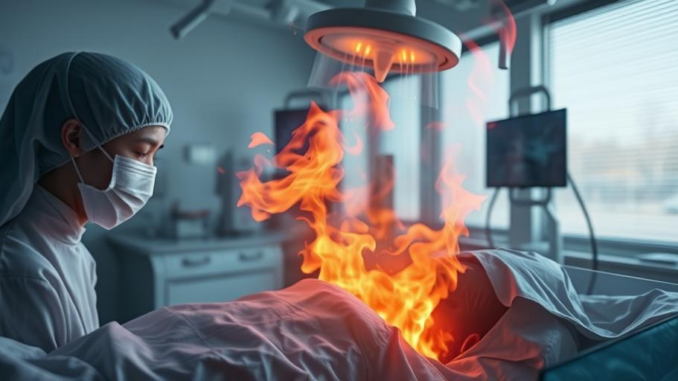
Summary
Spectral AI’s DeepView System outperforms burn physicians in identifying non-healing tissue, paving the way for faster, more accurate burn care. The system boasts significantly higher sensitivity and dice scores compared to clinical judgment. This breakthrough has the potential to revolutionize burn treatment and improve patient outcomes.
Healthcare data growth can be overwhelming scale effortlessly with TrueNAS by Esdebe.
** Main Story**
Okay, so you’ve probably heard about AI doing some pretty amazing things, but this one really caught my attention. Spectral AI’s DeepView System, it turns out, is giving burn doctors a run for their money. And honestly, it’s about time we leverage tech like this to improve patient care. This system uses fancy multispectral imaging, and some seriously smart algorithms, to assess burn wounds. The amazing thing? It predicts how well tissue will heal better than actual, experienced doctors. This could completely change burn care, leading to faster treatment and, more importantly, better results for patients.
Think about it, burns are incredibly complex, and getting an accurate assessment early on is critical. It’s not something you’d want to get wrong.
DeepView’s Tech Magic
How does this DeepView system work? Well, it captures super-detailed images of the burn using different wavelengths of light. Then, AI algorithms kick in, comparing these images to a massive database of validated clinical data. Basically, it can tell the difference between tissue that’s going to heal and tissue that’s not. This gives doctors a real-time, objective assessment of how bad the burn is and how it’s likely to heal. So far, so good, I guess?
The Study Results: A Big Deal
The Burn Validation Study was pretty huge – involved 164 patients, adults and kids both. And the results? Pretty clear-cut. DeepView blew the doctors out of the water in some key areas:
- Sensitivity: When it came to spotting non-healing tissue, DeepView was 86.6% accurate at the image level and 81.9% at the pixel level. Doctors? Only 40.8% and 38.8%, respectively. That’s a massive difference, I think you’ll agree.
- Dice Score: This measures how similar two samples are, and DeepView scored 68.5%, compared to the physicians’ 39.2%. Meaning it was way better at predicting the wound area.
Now, doctors were better at specificity (79.1% vs. 61.2%), which means they were better at correctly identifying tissue that would heal. But this probably just shows that doctors are naturally cautious in their assessments. And that is not a bad thing, but it can lead to longer heal times.
What This Means for Burn Care
The big picture here is that DeepView could really shake up burn care for the better. Because it can give such accurate and quick assessments, doctors can make smarter treatment decisions. It’s no magic bullet, but it can mean less complications and faster healing. I even read an article last year in the Lancet about the benefits of rapid assessment in trauma care, and the same principle applies here.
What’s Next?
Spectral AI is planning to submit these findings to the FDA by mid-2025 to get De Novo clearance. They’re hoping to launch the DeepView System in 2026. Beyond burn care, this tech could be used for other types of wounds and even other diagnostic areas. I mean, why wouldn’t you? That said, it will be interesting to see how this AI develops, and whether or not it fulfills it’s potential.
On a personal note, I had a minor burn a few years ago – nothing serious, just a clumsy moment with a hot pan. But even that little incident made me appreciate the importance of good burn care. If this technology can make a real difference for people with serious burns, then I’m all for it. I for one am looking forward to seeing what happens next, it could be a game changer.


DeepView, eh? Impressive tech! But will it also learn to offer patients a soothing cup of tea and a sympathetic ear like a good burn doctor? Just wondering if AI will nail the bedside manner too.
That’s a great point! While DeepView excels at objective assessment, the human touch is irreplaceable. Perhaps future AI advancements will incorporate empathy and communication skills, offering a more holistic approach to patient care. For now, it’s about augmenting, not replacing, the expertise of medical professionals.
Editor: MedTechNews.Uk
Thank you to our Sponsor Esdebe
The enhanced accuracy in predicting tissue healing offered by the DeepView system is remarkable. Combining this technology with the expertise of physicians could lead to more proactive interventions and personalized treatment plans, ultimately improving patient recovery times.
Thanks for highlighting the potential of proactive interventions! Combining DeepView’s accuracy with physicians’ expertise really opens doors to personalized treatment plans. Imagine tailoring therapies based on precise tissue healing predictions – it could truly revolutionize patient recovery!
Editor: MedTechNews.Uk
Thank you to our Sponsor Esdebe
Given the demonstrated accuracy in identifying non-healing tissue, how might DeepView be integrated into current clinical workflows to optimize treatment planning and resource allocation within burn units?
That’s a fantastic question! Integrating DeepView could involve using its initial assessment to triage patients more effectively, allocating resources to those identified as needing more intensive care earlier. This could also inform decisions on surgical interventions versus conservative management, leading to optimized resource allocation and better patient outcomes. What do you think?
Editor: MedTechNews.Uk
Thank you to our Sponsor Esdebe